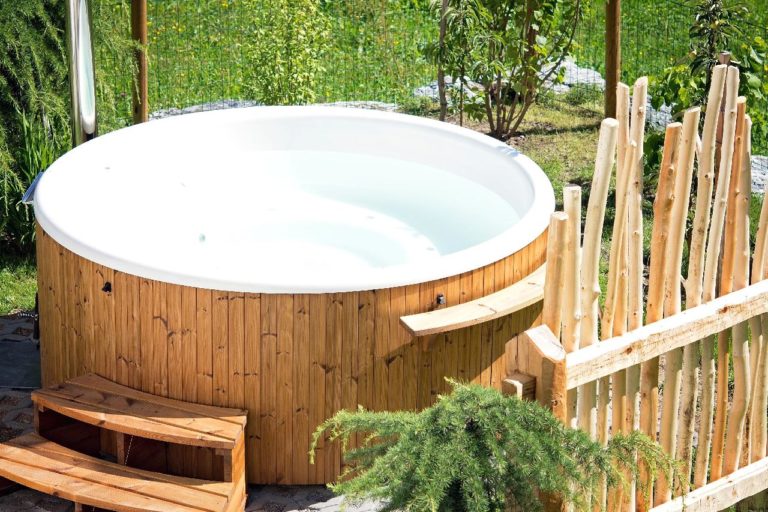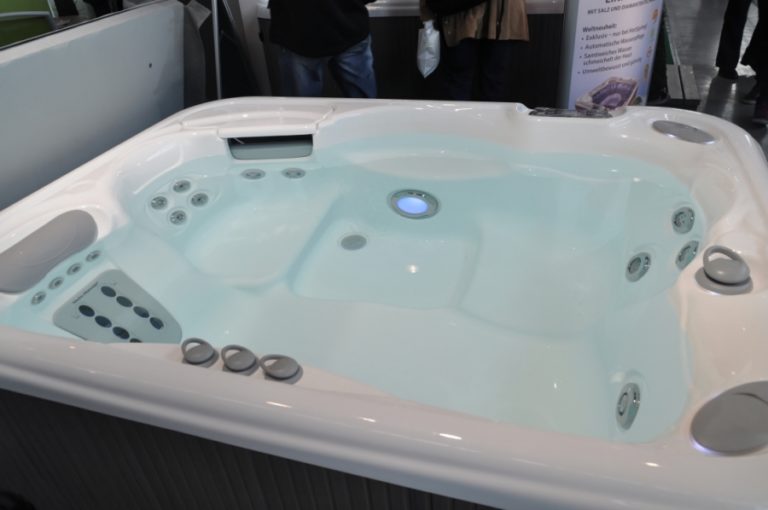Can you use an extension cord for a hot tub? What pros say
Many people use a hot tub in their backyard to relax after a tough day at work. Hot tubs provide many benefits to improve your mental and physical health. Installing a hot tub in your backyard is not difficult. You need a solid, level location, electricity, and a garden hose nearby. But for your preferred location, it is possible that the power cord is not long enough to reach the wall outlet. What should you do in this case?
Can you use an extension cord for a hot tub?
In general, it is not recommended to use a generic extension cord for a hot tub. In many cases, the power is too great for an extension cord to handle. If you need to use an extension cord, ensure you select a heavy-duty 14 gauge or thicker. Use the shortest possible length, and ensure that it is completely unwound. The extension cord should be water and weather-resistant for outdoor use, use a 3 prong grounded plug.

In this blog post, I will further explain how you can safely use an extension cord for your hot tub. I will also look at the questions if you can use a regular outlet for your hot tub. And at what depth a cable for your hot tub needs to be.
Contents
Can you use an extension cord for a hot tub?
I would not recommend using a generic extension cord to connect a hot tub to a wall outlet. Generic extension cords run the risk of heating up if they are not rated for higher power consumption. The cord supplied with the tub has thick enough wires to handle the power load the hot tub needs.
Many inflatable hot tub manufacturers warn against using an extension cord. Using an extension cord that has thinner wires may lead to overheating and fire. Similarly, using a long extension cord may cause a voltage drop. This can even damage under specific circumstances hot tub parts like the heater and jet pumps.
If an extension cord is needed, use a heavy-duty one with 14 gauge or thicker. The longer the extension, the thicker the wires should be. The cord should be water and weatherproof and rated for outdoor use if you use the hot tub out the door. Also, ensure that it uses a 3 prong grounded plug.
Try to use the shortest extension cord possible. And ensure that it is completely unwound. Wounded or partly wounded extension cords can get hot and even melt the reel extension cord enclosure.
Tubs, by default, come with cords that are 10 to 15 feet long and rated to function well with a suitable wall outlet. But if you are planning to place the tub further away, this could be too short. If you plan to install the hot tub permanently, I would recommend hiring a certified electrician to run a dedicated line to the tub location. If it will be a temporary location, using an extension cord is possible. But ensure that you use a suitable one.
Why can't you use an extension cord on a hot tub?
Tub owners tend to use extension cords when their hot tub is installed farther away than the 10 or 15 feet cord supplied with it. But using an extension cord As the length of the cord increases, it increases the resistance in conducting electricity through the cord. Increased resistance heats the cord. It may cause the extension cord to catch fire from overheating.
Similarly, a longer cord means more voltage loss as the length increases and damaging the equipment eventually. Even if you have connected the extension cord to a grounded GFCI receptacle, it will only take care of ground faults. It will not stop your cord from overheating to a toast. The fire risk is high if you use a lighter cable that is not rated to take a heavy load.
I do not recommend you to use an extension cord for connecting your spa due to these reasons. However, if you have no other options than using one, make sure it has a minimum AWG for the load needed for the tub to draw juice. Also, ensure that the cord is rated for outdoor usage. In any case, you need to strictly avoid adaptors or timers to connect the tub to the outlet.
Does a plug-and-play hot tub need a dedicated outlet?
A plug-and-play hot tub can use a regular outlet, as long as it is rated for 15 to 20-amp. This outlet should not be shared with other appliances. If you use it on a shared outlet, it may cause the breaker to keep tripping.
An average outlet in a house is usually fitted with a 15 AMP circuit breaker and is shared between appliances and rooms. When the spa pump and the heater are both working on full power, they can draw almost 15-amp from the outlet on its own. If other appliances are on simultaneously, this could increase the load above the 15-amp limit. And would cause the breaker to trip.
Some plug-and-play spas with higher capacity heating elements and a powerful pump can draw even more than 15-amp. They need a dedicated 20-amp outlet. Always check what your model needs.
– Existing outlets are often not dedicated
Covered patios are one of the common locations where people install plug-and-play hot tubs. You may be eying on that outside outlet in the patio to power up your tub. This may be a bad idea because most patio outlets are not dedicated outlets. They are also powering up nearby lights and other electrical appliances.
– Check your hot tub amperage requirement
If you plan to use an existing outside outlet for connecting your tub, ensure it is a dedicated one and meets the amperage requirement of your tub. Usually, the existing outlets are part of a circuit that other outlets share. You can test this by turning on appliances in the neighborhood. Then turn the circuit breaker off, and check what is not working. Try to move those to another location or using a different circuit.
– Do not use non-standard accessories
If you use wires with wrong gauge sizes or faulty connections, it will void the terms of the warranty for the tub. It can lead to unsafe situations and, under certain circumstances to damage the tub and electrical circuits under certain circumstances.
Do not use timers, plug adaptors, or converter plugs for connecting your spa to the outlet. If you do not know if your situation is suitable for a plug-and-play hot tub, ask a professional for help. And always ensure that everything you use is water and weatherproof.
Can I plug my hot tub into a regular outlet?
There are two types of hot tubs, models that use 110V and models that use 220V. Hot tubs that use 110V are also called plug-and-play hot tubs. For those, you can plug the spa into a suitable wall socket that supplies 15 to 20-amp. Models that need 220V need to be hardwired into a GFCI protected 220 to 240 volt 50 to 60-amp circuit.
– 110V plug and play hot tubs
For plug-and-play hot tubs, I would recommend using a dedicated outlet that is not shared by other appliances. If you use it on a shared outlet, it may cause the breaker to keep tripping.
An average outlet in a house is usually fitted with a 15 AMP circuit breaker and is shared between appliances and rooms. In usual instances, when only the spa is running, a 110 V plug-and-play tub will draw juice less than 15 AMP. However, if other appliances function simultaneously, it would increase the load above the 15 AMP limit. And it would cause the breaker to trip.
– 110V plug and play hot tubs that need a 20-amp supply
Some plug-and-play spas with more powerful pumps and heaters can draw more than 15 AMP. They need a 20-amp outlet. Ensure that your wall outlet can supply this.
– Hardwired 220V hot tubs
Most hardwired hot tubs need a 220V outlet. In contrast to what most people think, you also have 220V on your house. But this 220V is not readily available for the hot tub. It needs to be hardwired into a GFCI protected 220 to 240 volt 50 to 60-amp circuit.
Ask a professional for help if you need to do this.
Does hot tub wiring need to be buried?
If your outdoor hot tub is further away from your house, you need to bring electricity to it. For permanent installations, this cable is often buried in the ground. This way, you do not see an 'ugly' power cable running through your yard. But it is not a necessity to bury the cable.
If a cable is buried, you need to use a special armored ground cable. This cable needs to be buried 18 to 24 inches deep. You can also use liquid-tight to protect the cord in the burial.
Keeping the cable buried in a deep enough trench safeguards it from damage from digging or other activities that can take place near it. If you dig the trench, make a map of where it runs and at what depth. This makes it easier to find it back when there is a problem. Or if other work needs to be done on your garden, you know where to be careful.
Always consult a professional for help and check what is best in your situation.
How deep do you bury electrical wire in a hot tub?
For direct burial, I recommend a depth of 18 to 24 inches. This depth safeguards the cable from potential damage in the future when digging. Deeper is better. Also, use a special armored waterproof ground cable with a strong protective covering of the metal. Usually, they have an inner and outer jacket of PVC for additional protection.
If you cannot dig that deep, having other protective covering over the trench will keep the cord safer. Sometimes, digging an 18-inch deep trench is not feasible on the ground through which you are running the cord due to its hardness. In such cases, you can have a 12 inch deeper trench and place treated wood planks above it to keep the cord safer. However, always consult a certified electrician before deciding what to do.
All these precautions are to avoid any damage to the cable at a future digging event. It also ensures that it does not come in contact with water.
Apart from burying the wire, ensure that the tub is connected to the outlet at least 5 feet away. It should be safely away from coming in contact with water. Connect the spa into a covered outlet to ensure that the water does not come in contact with the plug,






